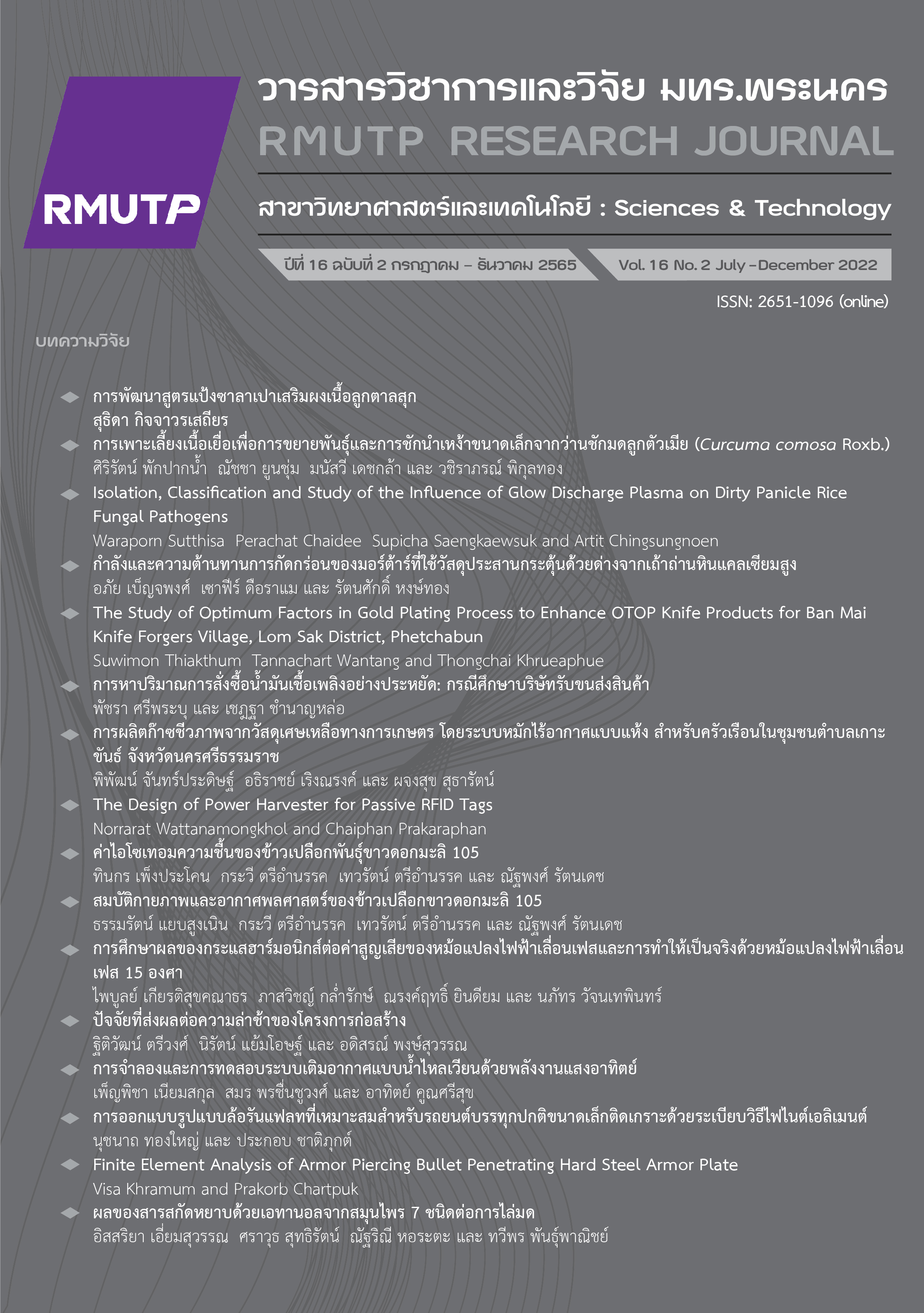Isolation, Classification and Study of the Influence of Glow Discharge Plasma on Dirty Panicle Rice Fungal Pathogens
Main Article Content
Abstract
This study was conducted to isolate and classify fungal dirty panicle disease pathogens from five rice varieties. Observation of rice seeds under stereo microscope showed that the seeds from all five varieties had 100% lesions of dirty panicle disease. When isolating the fungal pathogen with three methods, i.e. (i) ground rice seeds shaken in dH2O and then spread on potato dextrose agar (PDA), (ii) rice seeds washed with dH2O twice, then placed on PDA, and (iii) rice seeds shaken in 5% clorox for 5 min, after that washed with dH2O twice and then placed on PDA, 57 isolates of fungi were obtained. Morphological characterization classified the fungi into 17 genera, i.e. Alternaria, Arthrinium, Aspergillus, Biporalis, Botryotinia, Botrytis, Corynespora, Curvularia, Cylindrocarpon, Fusarium, Humicola, Monilinia, Mucor, Penicillium, Rhizopus, Stachybotrys and Stemphylium. Four genera, i.e. Alternaria, Bipolaris, Curvularia and Fusarium were reported to cause of dirty panicle disease of rice. The effect of glow discharge plasma on inhibition of fungal pathogen showed that exposed glow discharge plasma for 150s could inhibit mycelium growth of Curvularia but did not affect to Bipolaris and Fusarium.
Article Details

This work is licensed under a Creative Commons Attribution-NonCommercial-NoDerivatives 4.0 International License.
ลิขสิทธ์ ของมหาวิทยาลัยเทคโนโลยีราชมงคลพระนครReferences
K. Sangwijit, P. Thangsunan, R. Cutler and S. Anuntalabhochai, “Development of SCAR marker for Thai fragrant rice (Oryza sativa L. var. indica cv. Pathumthani 1) mutants induced by low energy ion beam,” Chiang Mai Journal of Science, vol. 39, no.4, pp. 545-553, 2012.
Investvine. (2013, Feb 1). Thailand wants rice top spot back. (Online). Available: https://www.bangkokpost. com/world/294585/thailand-to-retain-top-spot-in-rice-exports
The Nation. (2008, April 16). Rice strain is cause of comparatively low productivity. (Online). Available: https://en.wikipedia.org/wiki/Rice_production_in_Thailand
N. Ghosh. (2008, Feb 24). Thailand to set aside more land for farming. Straits Times. (Online). Available: https://wildsingaporenews.blogspot.com/2008/04/thailand-to-set-aside-more-land-for.html
P. Thavong, “Effect of dirty panicle disease on rice seed vigor,” Agricultural Research Journal, vol. 20, pp. 111-120, 2002.
C. Boonreung and S. Boonlertnirun, “Efficiency of chitosan for chitosan for controlling dirty panicle disease in rice plants,” ARPN Journal of Agricultural and Biological Science, vol. 8, no. 5, pp. 380-384, 2013.
S. Prathuangwong, D. Athinuwat, W. Chuaboon, T. Chatnaparat and N. Buensanteai, “Bioformulation Pseudomonas fluorescens SP007s against dirty panicle disease of rice,”African Journal Microbiology Research, vol. 7, no. 47, pp. 5274-5283, 2013.
K. Samanta, M. Jassal and A.K. Agrawal, “Atmospheric pressure glow discharge plasma and its applications in textile,” Indian Journal Fibre and Textile Research, vol. 31, pp. 83-98, 2006.
T.C. Montie, K. Kelly-Wintenberg and J.R. Roth, “An overview of research using the one atmosphere uniform glow discharge plasma (OAUGDP) for sterilization of surfaces and materials,” IEEE Transections and Plasma Science, vol. 28, no. 1, pp. 41-50, 2000.
S. Preechayan, K. Tonmitr, A. Suksriand and P. Siriputthaiwan, “Decontamination of aflatoxin producing fungi on agriculture products by atmospheric glow discharge plasma,” KKU Research Journal, vol. 15, no. 3, pp. 202-213, 2010.
A. Chingsungnoen, S. Maneerat, P. Chunpeng, P. Poolcharuansin and R. Nam-Matra, “Antimicrobial treatment of Escherichia coli and Staphylococcus aureus in herbal tea using low-temperature plasma,” Journal of Food Protection, vol. 81, no. 9, pp. 1503-1507, 2018.
P. Seelarak and P. Thummabenjapone, “Seed transmission of Fusarium spp. causal agent of bakanae disease in rice and potential of antagonistic Streptomyces-PR15 and Streptomyces-PR87 for control disease of economic crops caused by Fusarium spp.,” Khon Kaen Agricultural Journal, vol. 44 (suppl.), pp. 238-245, 2016.
T. Watanabe, Soil and Seed Fungi. Pictorial Atlas of Soil and Seed Fungi. Morphologies of Cultured Fungi and Key to Species. 2nd ed. CRC Press, Boca Raton, 2002.
H.L. Barnett and B.B. Hunter, Illustrated Genera of Imperfect Fungi. 3rd ed. Burgess Publishing Co., Minneapolis, 1972.
S. Saechow, A. Thammasittirong, P. Kittakoop, S. Prachya and S.N. Thammasittirong, “Antagonistic activity against dirty panicle rice fungal pathogens and plant growth-promoting activity of Bacillus amyloliquefaciens BAS23,” Journal of Microbiology and Biotechnology, vol. 28, no. 9, pp. 1527–1535, 2018.
B.O. Aronsson, J. Lausmaa and B. Kasemo, “Glow discharge plasma treatment for surface cleaning and modification of metallic biomaterials,” Journal of Biomedical Material Research, vol. 35, no. 1, pp. 49-73, 1997.
T. Youngblood and J.L. Ong, “Effect of plasma-glow discharge as a sterilization of titanium surfaces,” Implant Dentistry, vol. 12, no. 1, pp. 54-60, 2003.
K. Kelly-Wintenberg, T.C. Montie, C. Brickman, J.R. Roth, A.K. Carr, K. Sorge, L.C. Wadsworth and P.P.Y. Tsai, “Room temperature sterilization of surfaces and fabrics with a one atmosphere uniform glow discharge plasma,” Journal of Industrial Microbiology and Biotechnology, vol. 20, pp. 69–74, 1998.
T. Akitsua, H. Ohkawaa, M. Tsujib, H. Kimurab and M. Kogomac, “Plasma sterilization using glow discharge at atmospheric pressure,” Surface and Coating Technology, vol. 193, pp. 29–34, 2005.


